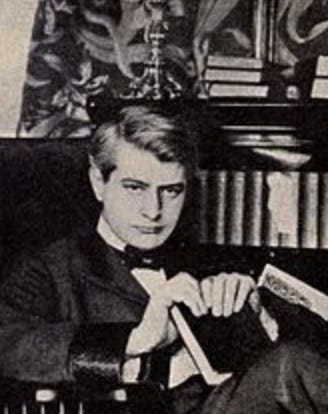TWA for Sunday, March 5, 2017
“Anxiety” by Jen Ashburn from The Light on the Wall. © Main Street Rag, 2017.
ORIGINAL TEXT AND AUDIO - 2017
It was on this day in 1750 that the first Shakespearean play was presented in America. Richard III was performed by the actors of Walter Murray and William Kean’s troupe from Philadelphia. Theater was still new in the colonies. And though it was popular in Philadelphia, that city still preferred to pride itself on its scientific and literary achievements, so Murray and Kean set out for New York City.
Through the 1700s, New York’s primary form of entertainment was drinking. By the time Murray and Kean arrived in February of 1750, there were 10,000 city residents and over 150 taverns. Murray and Kean set up shop in a two-story wooden structure on Nassau Street, slightly east of Broadway.
It’s the birthday of American novelist Frank Norris, best known for his novels McTeague (1899) and The Octopus (1901), which explored the effects of greed and capitalism on the human psyche. Norris was born Benjamin Franklin Norris in Chicago (1870). He moved with his father to San Francisco when he was 14. They lived at 1822 Sacramento Street. His older brother died when Norris was 17. He decided to study painting in Paris for two years, where he discovered the novels of Émile Zola and began reading about Darwin’s theories of human evolution.
Norris was a bit of a mess for a few years: he gave up on painting, failed to graduate from the University of California at Berkeley, and even worked as a news correspondent in South Africa, but became ill and had to return to the U.S. It was while working as a features writer in San Francisco for The Wave magazine that he was able to begin utilizing his ideas about class, capitalism, and the degradation of the human soul. Norris interviewed all walks of life for his stories, from tamale vendors to society matrons, and took meticulous notes on the toll and suffering that American greed caused.
His novel McTeague (1899) was a sensation. The story of a brutal, stupid dentist who harangues his wife and eventually kills her, only to die in Death Valley, the book galvanized readers and critics, some of whom called it “stomach-churning” and “vulgar.” Norris was determined to portray life in all its naturalistic fervor, including descriptions of urination and vomiting, which he had to rewrite for the English publication. His next novel, The Octopus (1901) — the first in a proposed trilogy about the struggle of California wheat growers against a monopolistic railway corporation — is considered his masterpiece.
Norris died at the age of 32 of a ruptured appendix, just when he was becoming successful. He’s a favorite son of San Francisco, with an alleyway named for him. Frank Norris Street runs from Polk Street to Larkin Street and is located parallel to and in between Pine Street and Bush Street in the city’s Lower Nob Hill district.
It’s the anniversary of the Boston Massacre, which took place on a cold and snowy night in 1770. It was touched off by an argument between a young barber’s apprentice and a British officer about payment for a haircut. The barber’s apprentice claimed that the officer had not paid, and the soldier reportedly knocked the kid down in the street.
A crowd of young men who were watching shouted at the officer, and they began throwing snowballs and pieces of ice at him. The officer fled to the Customs House nearby, where a sentry stood guard with his musket. Other soldiers came out of the Customs House to help defend the men against the crowd, which was growing. Someone rang the fire bell, and more people flooded the streets to see what was happening. The crowd grew rowdier, throwing ice, oyster shells, and lumps of sea coal. The soldiers brandished their weapons, but the crowd dared them to shoot, calling them cowards.
Suddenly shots rang out. When the smoke cleared, five colonists were dead or dying — Crispus Attucks, Patrick Carr, Samuel Gray, Samuel Maverick, and Christopher Monk — and three more were injured. It was hardly a massacre, but the more revolutionary members of the colonies played it up as much as they could.
The soldiers were put on trial, and it turned out that the man chosen to represent them was the American patriot John Adams. He didn’t support the British by any means, but he was told that no one else would take the case, and he believed that all men deserve a good defense under the law. So he took the case, and he managed to get most of the soldiers acquitted.
It’s the birthday of Gerardus Mercator, born in Rupelmonde, Flanders (now Belgium), in 1512. He developed the world-mapping technique that we still use today and call the “Mercator projection.” He developed a method to accurately project the globe onto a flat surface so that longitude and latitude lines would always be at right angles to each other.
When he first published his world map in 1569, it revolutionized navigation. For the first time, sailors could plot a route between any two destinations in the world using a straight line, and then follow that route without having to adjust their compasses.
To project the globe onto a flat surface, Mercator straightened the vertical lines of longitude into parallel lines, and he added space between the horizontal lines of latitude. This distorted the distance at the North and South Poles, which is why Greenland and Antarctica appear so large on flat world maps. The Mercator projection soon became the authoritative world map. Mercator was also the first person to use the word “atlas” to refer to a book of maps.
Be well, do good work, and keep in touch.®
RELEASE WEEK - March 7th
That Time of Year: A Minnesota Life (slightly revised) Softcover





